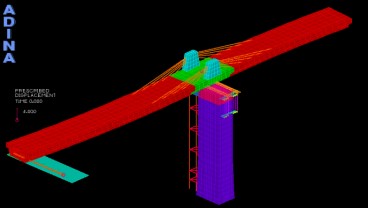Using sophisticated material models in ADINA software Featured

Sophisticated material models and reliable finite element solvers are necessary when using advanced polymers in challenging engineering applications. Viscoelastic effects, that involve time-dependent behavior, can be significant when polymeric components are employed. For instance, materials like ultra-high molecular weight polyethylene are utilized in biomedical applications, while polytetrafluoroethylene (PTFE), commonly known as "Teflon," finds extensive use in industrial sealing and bearing applications due to its low friction, chemical inertness, and remarkable resistance to high temperatures, corrosion, and stress cracking. In many cases, these components experience significant deformations caused by factors such as contact, temperature changes, and other nonlinearities. Therefore, it is crucial to have a proper understanding of the viscoelastic properties of these components.
In order to meet the demands of customers, ADINA supports the Bergström-Boyce and Three-Network viscoelastic material models. These material models, which can be considered as advanced, enable users to accurately capture the intricate viscoelastic behaviors exhibited by polymeric components. ADINA provides powerful solvers, an extensive element library, and multiphysics capabilities, empowering users to fully utilize these material models and their benefits.
The small punch test is a widely used technique for evaluating materials. It involves placing a disk-shaped specimen inside a die and applying a punch to it. The punch is pushed against the specimen at a rate of 0.5mm/min, and the resulting force is measured as a function of the displacement. In this particular scenario, the material under examination is high-density polyethylene. Figure 1 shows the experimental setup of this technique.

Figure 2 presents a comparison between the predictions obtained from 3D-solid and axisymmetric analyses, and the experimental findings reported by Bergström and Bischoff [1]. ADINA's Three-Network model was utilized to simulate the material behavior during the testing process, and the material parameters were derived from Ref. [1]. These models account for frictional contact effects as well. ADINA's robust higher-order u/p elements effectively address issues like volumetric and shear locking that may arise in cases of severe deformation.
The results clearly show that ADINA's Three-Network model implementation closely matches the experimental results for polyethylene. Both the three-dimensional and axisymmetric two-dimensional cases yield virtually identical predictions, which exhibit a favorable comparison with the experimental data. It's worth noting that the axisymmetric model offers lower computational cost, although it cannot capture any asymmetric modes that may be triggered under extreme compressive stresses.

Thermal effects like as expansion/contraction and temperature-dependent viscoelastic behaviors can be considered via the Bergstrom-Boyce and Three-Network material models. Additionally, viscoelastic materials exhibit dissipation, meaning they generate heat during deformation. ADINA has the capability to predict the internal heat generation in a fully-coupled thermomechanical analysis.
In Figure 3, the Three-Network model is employed in conjunction with ADINA's 3D-shell element to simulate a rubber CV-joint boot. This model incorporates self-contact and temperature effects within a fully-coupled thermomechanical analysis. The internal dissipation within the material is treated as heat generation, which is accounted for in the analysis.

As designs become increasingly intricate and the significance of complex material behaviors grows in terms of overall performance, the selection of suitable material models for the analysis becomes equally crucial. ADINA provides analysts with a comprehensive library of advanced material models and finite element formulations, solvers, and contact algorithms. These tools can be effectively employed in conjunction with advanced material models for various multiphysics applications, ensuring reliable and accurate results.
References
[1] J.S. Bergström and J.E. Bischoff, "An Advanced Thermomechanical Constitutive Model for UHMWPE," Int. J. Struct. Changes Sol., 2:31–39, 2010.
[2] J.S. Bergström and M.C. Boyce, "Constitutive modeling of the large strain time–dependent behavior of elastomers," J. Mech. Phys. Solids, 46:931–954, 1998.
Source: Advanced Material Models in ADINA
Want to read more like this story?

ADINA provides advanced material models
Aug, 01, 2023 | NewsADINA offers advanced material models in response to the need for advanced polymers in challenging...

Domed roof analysis of a railway station
Apr, 28, 2023 | NewsSouthwest Jiaotong University studied the structural integrity of the roof of a huge railway statio...

ADINA 2025 New Release!
May, 13, 2025 | NewsBentley Systems announced a new major release of ADINA. For a complete list of changes see ADINA...

ADINA Structures
Jun, 03, 2022 | Software
ADINA 2024 New Release!
Sep, 06, 2024 | NewsProduct versioning for Bentley Systems is now based on the calendar year of the major release accor...

How advanced finite element analysis can prepare buildings for extreme events
Nov, 14, 2024 | NewsWhile most structural analysis software can evaluate everyday stresses, they often fail to prepare...

ADINA 2025 for Structural WorkSuite
May, 13, 2025 | NewsThe Structural WorkSuite provides access to the RAM and STAAD structural analysis products and now...

It’s a good time to be a Structural Engineer!
Feb, 06, 2024 | NewsRead our interview with Joshua Taylor, PE (CA, WA), Senior Director of Product Management and Jan...

Bentley Systems Announces Acquisition of ADINA to Extend Nonlinear Simulation throughout Infrastructure Engineering
May, 05, 2022 | NewsBentley Systems announced it has acquired Watertown, Massachusettsbased ADINA R & D Inc., a lea...
Form
Looking for more information? Fill in the form and we will contact Bentley for you.
Trending

Spectacular interchanges around the world

New Release - STAAD.Pro 2024 - 2

Concrete Buildings as Rechargeable Batteries

Drilled Shafts Project on Gilbert Road Bridge

Keller employees receive ADSC President’s Award

Powerful earthquake shakes central Philippines, dozens killed

Indonesia school collapse: three fatalities and dozens injured

